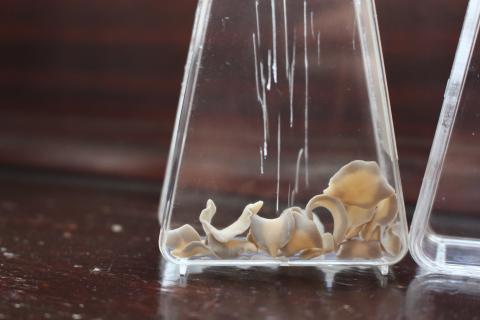Gaining a better understanding of the infection cycle and seasonal risks of liver fluke are the first steps towards more effective treatment and control on farms.
Liver fluke affects sheep and cattle of all ages and can reduce liveweight gains by 10% in adults and 30% in lambs and calves. The prevalence of liver fluke is significantly influenced by the weather, particularly mild winters and wet summers, and after a high risk winter and pasture contamination earlier this year, the National Animal Disease Information Service (NADIS) has forecast a very high risk of liver fluke this autumn and winter.
“As well as reductions in liveweight gains, there are also indirect costs such as poor reproductive performance in both sheep and cattle,” said Dr Philip Skuce, a principal scientist with the Moredun Research Institute, who was speaking at a series of events arranged by Farming Connect to raise awareness of liver fluke.
The clinical signs of liver fluke include sudden death, severe abdominal pain and animals that are unwilling or unable to move. They may also develop bottle jaw and anaemia, along with general ill-thrift, weight loss and poor performance and condition.
To diagnose fluke, blood samples can be taken for liver enzymes and fluke antibodies and bulk tank milk samples can be analysed. Faecal egg counts are the most popular diagnostic method, but as fluke eggs are released intermittently, it can lead to difficulties interpreting results.
The complicated lifecycle of liver fluke can also make treatment difficult. Adult fluke in the animal’s liver shed eggs which pass out through faeces onto pasture. A larvae develops inside the egg which hatches out and enters a mud snail, where it can multiply up to 500 times. The larvae are eventually shed from the snail and stay on pasture as cysts which are ingested by grazing animals. Once inside the animal the cysts hatch into immature fluke and within 10 to 12 weeks eggs will be produced, starting the cycle again.
“Having a working knowledge of the lifecycle is really important,” added Dr Skuce. “It dictates what’s happening on your farm, it also dictates your treatment options and some of your diagnostic options.”
As most flukicides don’t kill all stages of fluke, understanding the lifecycle to determine the best product to use is essential. Triclabendazole has the widest activity against all stages of fluke, but this has led to overuse and resistance to the drug is now being reported.
“Another important point is that drugs that kill roundworms tend not to kill fluke,” emphasised Dr Skuce.
Farmers were also urged not to treat with drugs only, without implementing other control options.
“Unfortunately that’s not sustainable, we need to try other ways of doing things, treatment is certainly part of it, but it’s just one part of an overall picture.”
The four-point control plan is based on seasonal actions affecting the fluke lifecycle:
Spring: Protect pastures by not allowing animals to shed eggs which can get into the mud snails, either by keeping stock off pasture or using products to kill adult fluke and prevent them laying eggs.
Summer: Reduce the mud snail population through draining wet areas, topping rushes which can harbour mud snails and improving poached areas so they don’t hold water.
Autumn: Avoiding high cyst challenge by grazing animals away from known or suspected high risk areas. Temporary fencing can be set up to keep animals away from boggy areas.
Winter: Strategic treatment of ‘at risk’ animals with appropriate products.
“With treatment, you must treat the right animals at the right time with the right product at the right dose. That is so important.”
When considering management options, farmers were urged to make best use of all information such as their farm history and location, abattoir returns, diagnostic samples, climatic conditions and on-farm risk factors. People should also work with their vet and animal health advisor to devise sustainable fluke control strategies tailored to individual farms.
Farming Connect also offer an e-learning resource on managing liver fluke on your farm.
A series of roadshows aimed to raise awareness of liver fluke disease, which is predicted to pose a high risk in western areas of the UK this winter.
Liver fluke affects cattle and sheep of all ages.
The tiny mud snail that acts as an intermediate host for liver fluke.



